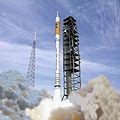Bestand:Aiaa2.jpg

Grootte van deze voorvertoning: 600 × 600 pixels. Andere resoluties: 240 × 240 pixels | 639 × 639 pixels.
Oorspronkelijk bestand (639 × 639 pixels, bestandsgrootte: 84 kB, MIME-type: image/jpeg)
Bestandsgeschiedenis
Klik op een datum/tijd om het bestand te zien zoals het destijds was.
| Datum/tijd | Miniatuur | Afmetingen | Gebruiker | Opmerking | |
|---|---|---|---|---|---|
| huidige versie | 3 nov 2008 17:18 |  | 639 × 639 (84 kB) | Aaaf-wiki~commonswiki | {{Information |Description={{en|1=JSC2008e039697, 2008 - The Ares I Crew Launch Vehicle is being developed at Marshall Space Flight Center in Huntsville, Alabama, and is a two-stage vehicle designed solely for carrying the Orion CEV to Earth orbit. The 9 |
Bestandsgebruik
Dit bestand wordt op de volgende pagina gebruikt:
Globaal bestandsgebruik
De volgende andere wiki's gebruiken dit bestand:
- Gebruikt op ar.wikipedia.org
- Gebruikt op de.wikipedia.org
- Gebruikt op en.wikipedia.org
- Gebruikt op he.wikipedia.org
- Gebruikt op hr.wikipedia.org
- Gebruikt op nl.wikipedia.org
- Gebruikt op no.wikipedia.org
- Gebruikt op ru.wikipedia.org
- Gebruikt op sr.wikipedia.org
- Gebruikt op tr.wikipedia.org


